Automated Estimation of Sub-Canopy Topography Combined with Single-Baseline Single-Polarization TanDEM-X InSAR and ICESat-2 Data
Abstract
:1. Introduction
- (1)
- Modeling to estimate SPC height using only the interferometric coherence and slope obtained from TanDEM-X InSAR data. Compared with optical parameters, TanDEM-X InSAR interferometric coherence records the scattering process of InSAR signals in the forest and is sensitive to forest height, vertical structure, and dielectric properties. More importantly, it exhibits time synchronization and consistency in spatial resolution with the InSAR-derived DEM.
- (2)
- ICESat-2 terrain control points (TCPs) with similar forest and slope conditions were adaptively screened within a local area to establish the model. The highlight of the framework for the estimation of SPC height is that the screening strategy comprehensively considers the spatial heterogeneity of forest characteristics and the influence of slope. In addition, the adaptive selection of TCPs enables the framework to estimate the SPC height well when ICESat-2 data are sparse.
- (3)
- A weighted least-squares criterion was used to solve the model to estimate the SPC height, which can adapt to the influence on the results of different distances of the ICESat-2 TCPs.
2. Methods
2.1. Scattering Phase Center Height Retrieval Algorithm
2.2. Estimation of the SPC Height
- (1)
- Condition 1: Search within a local circular area with the pixel to be predicted as the center and R as the radius. The initial value of R can be empirically set based on the existing coverage density of ICESat-2, which is 100 pixels in this study. We assumed that forest conditions (i.e., type, density, and dielectric properties) were the same or similar within a local area. When the slope is zero, different interferometric coherences correspond to different SPC heights.
- (2)
- Condition 2: Based on Condition 1, ICESat-2 TCPs with the same slope direction (positive or negative) were selected to solve the orthogonal polynomial model. As shown in Figure 2, when a certain terrain slope exists, it leads to a higher or lower SPC height at the same geographical location [20]. In addition, the slope distorts the relationship between interferometric coherence and SPC height. In the positive slope area, the interferometric coherence decreased with an increase in slope, because the increase in slope leads to an increase in volume scattering caused by the forest canopy in the same forest environment [41]. Conversely, in the negative slope area, the increase in slope increases the surface scattering that occurs at the top of the forest, whereas the volumetric scattering caused by the forest canopy decreases. Therefore, this selection condition was beneficial for avoiding the heterogeneity caused by different slope directions to better predict the SPC height.
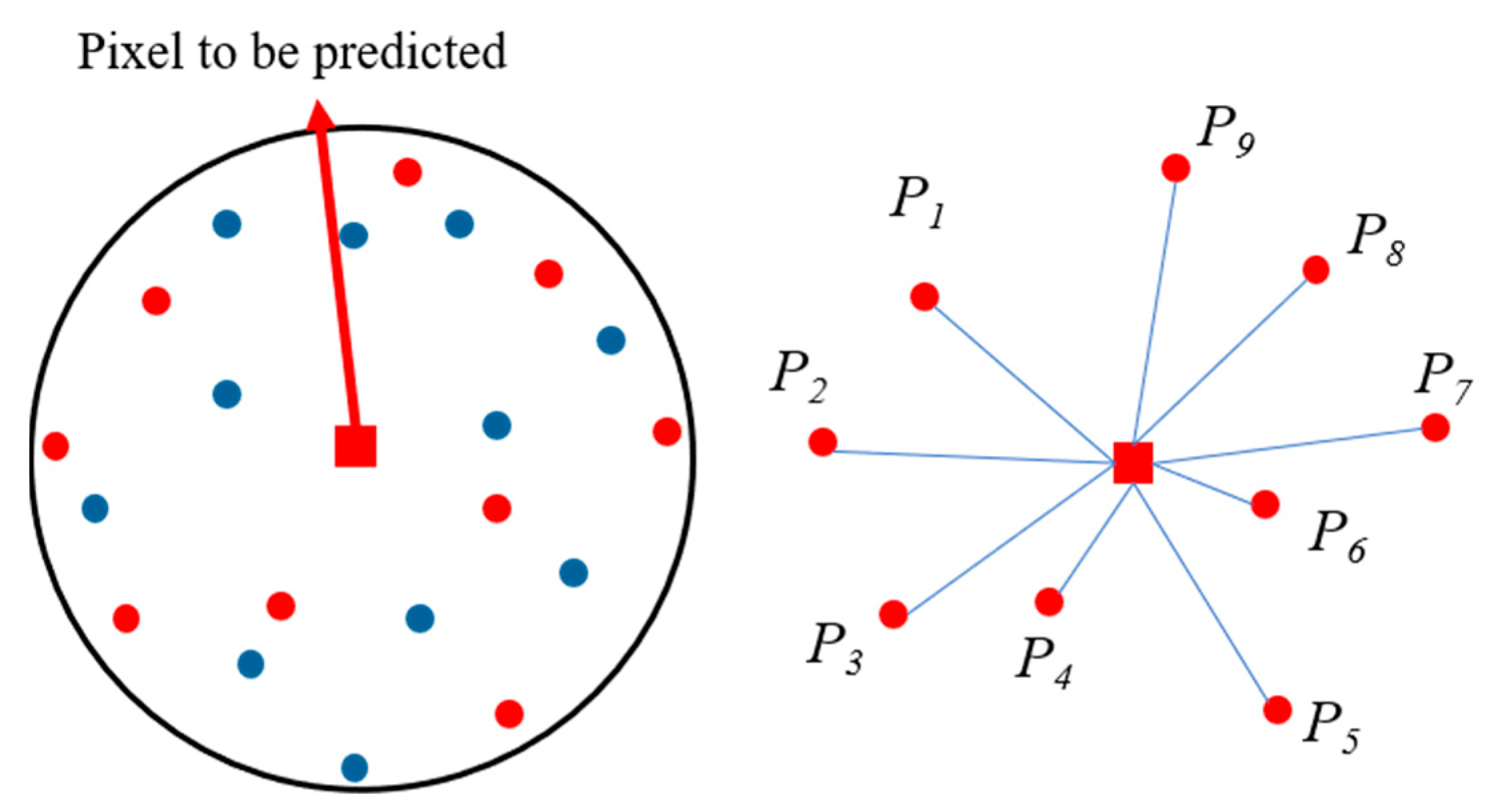
3. Study Area and Data
3.1. Study Area
3.2. Datasets
3.2.1. TanDEM-X InSAR Data
3.2.2. ICESat-2 ATL08 Data
3.2.3. Forest Non-Forest Map
3.2.4. Airborne LiDAR Data
4. Results
4.1. Comparison of InSAR-Derived DEM and LiDAR Data in Vegetated Areas
4.2. Validation of Estimated Sub-Canopy Topography with Airborne LiDAR DTM
5. Discussion
5.1. Advantages of Using Coherence and Local Modeling
5.2. Correlation between Forest Height and the Accuracy of Sub-Canopy Topography
5.3. Limitations and Future Enhancements
6. Conclusions
Author Contributions
Funding
Data Availability Statement
Acknowledgments
Conflicts of Interest
References
- De Paiva, R.C.D.; Buarque, D.C.; Collischonn, W.; Bonnet, M.-P.; Frappart, F.; Calmant, S.; Bulhoes Mendes, C.A. Large-Scale Hydrologic and Hydrodynamic Modeling of the Amazon River Basin. Water Resour. Res. 2013, 49, 1226–1243. [Google Scholar] [CrossRef]
- Baade, J.; Schmullius, C. TanDEM-X IDEM Precision and Accuracy Assessment Based on a Large Assembly of Differential GNSS Measurements in Kruger National Park, South Africa. ISPRS J. Photogramm. Remote Sens. 2016, 119, 496–508. [Google Scholar] [CrossRef]
- Ma, R.J. DEM Generation and Building Detection from Lidar Data. Photogramm. Eng. Remote Sens. 2005, 71, 847–854. [Google Scholar] [CrossRef]
- Abrams, M.; Crippen, R.; Fujisada, H. ASTER Global Digital Elevation Model (GDEM) and ASTER Global Water Body Dataset (ASTWBD). Remote Sens. 2020, 12, 1156. [Google Scholar] [CrossRef]
- Farr, T.G.; Rosen, P.A.; Caro, E.; Crippen, R.; Duren, R.; Hensley, S.; Kobrick, M.; Paller, M.; Rodriguez, E.; Roth, L.; et al. The Shuttle Radar Topography Mission. Rev. Geophys. 2007, 45, RG2004. [Google Scholar] [CrossRef]
- Krieger, G.; Fiedler, H.; Zink, N.; Hajnsek, I.; Younis, M.; Huber, S.; Bachmann, M.; Gonzalez, J.H.; Werner, M.; Moreira, A. The TanDEM-X Mission: A Satellite Formation for High-Resolution SAR Interferometry. In Proceedings of the 2007 European Radar Conference, Munich, Germany, 10–12 October 2007; IEEE: New York, NY, USA, 2007; pp. 83–86. [Google Scholar]
- Rizzoli, P.; Martone, M.; Gonzalez, C.; Wecklich, C.; Tridon, D.B.; Braeutigam, B.; Bachmann, M.; Schulze, D.; Fritz, T.; Huber, M.; et al. Generation and Performance Assessment of the Global TanDEM-X Digital Elevation Model. ISPRS J. Photogramm. Remote Sens. 2017, 132, 119–139. [Google Scholar] [CrossRef]
- Rossi, C.; Gonzalez, F.R.; Fritz, T.; Yague-Martinez, N.; Eineder, M. TanDEM-X Calibrated Raw DEM Generation. ISPRS J. Photogramm. Remote Sens. 2012, 73, 12–20. [Google Scholar] [CrossRef]
- Wang, H.; Fu, H.; Zhu, J.; Liu, Z.; Zhang, B.; Wang, C.; Li, Z.; Hu, J.; Yu, Y. Estimation of Subcanopy Topography Based on Single-Baseline TanDEM-X InSAR Data. J. Geod. 2021, 95, 84. [Google Scholar] [CrossRef]
- Fu, H.; Zhu, J.; Wang, C.; Wang, H.; Zhao, R. Underlying Topography Estimation over Forest Areas Using High-Resolution P-Band Single-Baseline PolInSAR Data. Remote Sens. 2017, 9, 363. [Google Scholar] [CrossRef]
- Fu, H.; Zhu, J.; Wang, C.; Li, Z. Underlying Topography Extraction over Forest Areas from Multi-Baseline PolInSAR Data. J. Geod. 2018, 92, 727–741. [Google Scholar] [CrossRef]
- Liao, Z.; He, B.; Bai, X.; Quan, X. Improving Forest Height Retrieval by Reducing the Ambiguity of Volume-Only Coherence Using Multi-Baseline PolInSAR Data. IEEE Trans. Geosci. Remote Sens. 2019, 57, 8853–8866. [Google Scholar] [CrossRef]
- Cloude, S.R.; Papathanassiou, K.P. Polarimetric SAR Interferometry. IEEE Trans. Geosci. Remote Sens. 1998, 36, 1551–1565. [Google Scholar] [CrossRef]
- Papathanassiou, K.P.; Cloude, S.R. Single-Baseline Polarimetric SAR Interferometry. IEEE Trans. Geosci. Remote Sens. 2001, 39, 2352–2363. [Google Scholar] [CrossRef]
- Fu, H.Q.; Zhu, J.J.; Wang, C.C.; Zhao, R.; Xie, Q.H. Underlying Topography Estimation over Forest Areas Using Single-Baseline InSAR Data. IEEE Trans. Geosci. Remote Sens. 2019, 57, 2876–2888. [Google Scholar] [CrossRef]
- Peng, X.; Li, X.; Wang, C.; Zhu, J.; Liang, L.; Fu, H.; Du, Y.; Yang, Z.; Xie, Q. SPICE-Based SAR Tomography over Forest Areas Using a Small Number of P-Band Airborne F-SAR Images Characterized by Non-Uniformly Distributed Baselines. Remote Sens. 2019, 11, 975. [Google Scholar] [CrossRef]
- Aghababaei, H.; Ferraioli, G.; Ferro-Famil, L.; Huang, Y.; D’Alessandro, M.M.; Pascazio, V.; Schirinzi, G.; Tebaldini, S. Forest SAR Tomography: Principles and Applications. IEEE Geosci. Remote Sens. Mag. 2020, 8, 30–45. [Google Scholar] [CrossRef]
- Shiroma, G.H.X.; Lavalle, M. Digital Terrain, Surface, and Canopy Height Models From InSAR Backscatter-Height Histograms. IEEE Trans. Geosci. Remote Sens. 2020, 58, 3754–3777. [Google Scholar] [CrossRef]
- Gallant, J.C.; Read, A.M.; Dowling, T.I. REMOVAL OF TREE OFFSETS FROM SRTM AND OTHER DIGITAL SURFACE MODELS. Int. Arch. Photogramm. Remote Sens. Spat. Inf. Sci. 2012, 39, 275–280. [Google Scholar] [CrossRef]
- Su, Y.; Guo, Q. A Practical Method for SRTM DEM Correction over Vegetated Mountain Areas. ISPRS J. Photogramm. Remote Sens. 2014, 87, 216–228. [Google Scholar] [CrossRef]
- Su, Y.; Guo, Q.; Ma, Q.; Li, W. SRTM DEM Correction in Vegetated Mountain Areas through the Integration of Spaceborne LiDAR, Airborne LiDAR, and Optical Imagery. Remote Sens. 2015, 7, 11202–11225. [Google Scholar] [CrossRef]
- O’Loughlin, F.E.; Paiva, R.C.D.; Durand, M.; Alsdorf, D.E.; Bates, P.D. A Multi-Sensor Approach towards a Global Vegetation Corrected SRTM DEM Product. Remote Sens. Environ. 2016, 182, 49–59. [Google Scholar] [CrossRef]
- Tan, P.; Zhu, J.; Fu, H.; Wang, C.; Liu, Z.; Zhang, C. Sub-Canopy Topography Estimation from TanDEM-X DEM by Fusing ALOS-2 PARSAR-2 InSAR Coherence and GEDI Data. Sensors 2020, 20, 7304. [Google Scholar] [CrossRef] [PubMed]
- Hawker, L.; Uhe, P.; Paulo, L.; Sosa, J.; Savage, J.; Sampson, C.; Neal, J. A 30 m Global Map of Elevation with Forests and Buildings Removed. Environ. Res. Lett. 2022, 17, 024016. [Google Scholar] [CrossRef]
- Zhogolev, A.; Savin, I. The Influence Correction of Boreal Forest Vegetation on SRTM Data. Geocarto Int. 2018, 33, 573–586. [Google Scholar] [CrossRef]
- Magruder, L.; Neuenschwander, A.; Klotz, B. Digital Terrain Model Elevation Corrections Using Space-Based Imagery and ICESat-2 Laser Altimetry. Remote Sens. Environ. 2021, 264, 112621. [Google Scholar] [CrossRef]
- Kulp, S.A.; Strauss, B.H. CoastalDEM: A Global Coastal Digital Elevation Model Improved from SRTM Using a Neural Network. Remote Sens. Environ. 2018, 206, 231–239. [Google Scholar] [CrossRef]
- Enwright, N.M.; Kranenburg, C.J.; Patton, B.A.; Dalyander, P.S.; Brown, J.A.; Piazza, S.C.; Cheney, W.C. Developing Bare-Earth Digital Elevation Models from Structure-from-Motion Data on Barrier Islands. ISPRS J. Photogramm. Remote Sens. 2021, 180, 269–282. [Google Scholar] [CrossRef]
- Rahman, M.M.; Csaplovics, E.; Koch, B. An Efficient Regression Strategy for Extracting Forest Biomass Information from Satellite Sensor Data. Int. J. Remote Sens. 2005, 26, 1511–1519. [Google Scholar] [CrossRef]
- Martone, M.; Braeutigam, B.; Rizzoli, P.; Gonzalez, C.; Bachmann, M.; Krieger, G. Coherence Evaluation of TanDEM-X Interferometric Data. ISPRS J. Photogramm. Remote Sens. 2012, 73, 21–29. [Google Scholar] [CrossRef]
- Lopez-Sanchez, J.M.; Vicente-Guijalba, F.; Erten, E.; Campos-Taberner, M.; Javier Garcia-Haro, F. Retrieval of Vegetation Height in Rice Fields Using Polarimetric SAR Interferometry with TanDEM-X Data. Remote Sens. Environ. 2017, 192, 30–44. [Google Scholar] [CrossRef]
- Martone, M.; Brautigam, B.; Krieger, G. Quantization Effects in TanDEM-X Data. IEEE Trans. Geosci. Remote Sens. 2015, 53, 583–597. [Google Scholar] [CrossRef]
- Rizzoli, P.; Dell’Amore, L.; Bueso-Bello, J.-L.; Gollin, N.; Carcereri, D.; Martone, M. On the Derivation of Volume Decorrelation from TanDEM-X Bistatic Coherence. IEEE J. Sel. Top. Appl. Earth Obs. Remote Sens. 2022, 15, 3504–3518. [Google Scholar] [CrossRef]
- Balss, U.; Breit, H.; Duque, S. TanDEM-X Payload Ground Segment: CoSSC Generation and Interferometric Considerations. Ger. Aerosp. Cent. 2012. Available online: https://tandemx-science.dlr.de/ (accessed on 1 December 2023).
- Rabus, B.; Eineder, M.; Roth, A.; Bamler, R. The Shuttle Radar Topography Mission—A New Class of Digital Elevation Models Acquired by Spaceborne Radar. ISPRS J. Photogramm. Remote Sens. 2003, 57, 241–262. [Google Scholar] [CrossRef]
- Al-Nuaimi, M.O.; Hammoudeh, A.M. Measurements and Predictions of Attenuation and Scatter of Microwave Signals by Trees. IEE Proc. Microw. Antennas Propag. 1994, 141, 70–76. [Google Scholar] [CrossRef]
- Wang, F.; Sarabandi, K. A Physics-Based Statistical Model for Wave Propagation through Foliage. IEEE Trans. Antennas Propag. 2007, 55, 958–968. [Google Scholar] [CrossRef]
- Caicoya, A.T.; Kugler, F.; Hajnsek, I.; Papathanassiou, K.P. Large-Scale Biomass Classification in Boreal Forests with TanDEM-X Data. IEEE Trans. Geosci. Remote Sens. 2016, 54, 5935–5951. [Google Scholar] [CrossRef]
- Persson, H.J.; Olsson, H.; Soja, M.J.; Ulander, L.M.H.; Fransson, J.E.S. Experiences from Large-Scale Forest Mapping of Sweden Using TanDEM-X Data. Remote Sens. 2017, 9, 1253. [Google Scholar] [CrossRef]
- Cloude, S.R. Polarisation: Applications in Remote Sensing; Oxford University Press: London, UK, 2009. [Google Scholar]
- Denbina, M.; Simard, M. The Effects of Temporal Decorrelation and Topographic Slope on Forest Height Retrieval Using Airborne Repeat-Pass L-Band Polarimetric SAR Interferometry. In Proceedings of the 2016 IEEE International Geoscience and Remote Sensing Symposium (IGARSS), Beijing, China, 10–15 July 2016; pp. 1745–1748. [Google Scholar]
- Nievergelt, Y. A Tutorial History of Least Squares with Applications to Astronomy and Geodesy. J. Comput. Appl. Math. 2000, 121, 37–72. [Google Scholar] [CrossRef]
- Lee, J. A Reformulation of Weighted Least Squares Estimators. Am. Stat. 2009, 63, 49–55. [Google Scholar] [CrossRef]
- Lu, G.Y.; Wong, D.W. An Adaptive Inverse-Distance Weighting Spatial Interpolation Technique. Comput. Geosci. 2008, 34, 1044–1055. [Google Scholar] [CrossRef]
- Markus, T.; Neumann, T.; Martino, A.; Abdalati, W.; Brunt, K.; Csatho, B.; Farrell, S.; Fricker, H.; Gardner, A.; Harding, D.; et al. The Ice, Cloud, and Land Elevation Satellite-2 (ICESat-2): Science Requirements, Concept, and Implementation. Remote Sens. Environ. 2017, 190, 260–273. [Google Scholar] [CrossRef]
- Magruder, L.; Neumann, T.; Kurtz, N. ICESat-2 Early Mission Synopsis and Observatory Performance. Earth Space Sci. 2021, 8, e2020EA001555. [Google Scholar] [CrossRef] [PubMed]
- Neuenschwander, A.; Pitts, K. The ATL08 Land and Vegetation Product for the ICESat-2 Mission. Remote Sens. Environ. 2019, 221, 247–259. [Google Scholar] [CrossRef]
- Li, Y.; Fu, H.; Zhu, J.; Wang, C. A Filtering Method for ICESat-2 Photon Point Cloud Data Based on Relative Neighboring Relationship and Local Weighted Distance Statistics. IEEE Geosci. Remote Sens. Lett. 2021, 18, 1891–1895. [Google Scholar] [CrossRef]
- Martone, M.; Rizzoli, P.; Wecklich, C.; Gonzalez, C.; Bueso-Bello, J.-L.; Valdo, P.; Schulze, D.; Zink, M.; Krieger, G.; Moreira, A. The Global Forest/Non-Forest Map from TanDEM-X Interferometric SAR Data. Remote Sens. Environ. 2018, 205, 352–373. [Google Scholar] [CrossRef]
- Hajnsek, I.; Scheiber, R.; Lee, S.; Ulander, L.; Gustavsson, A.; Tebaldini, S.; Monte Guarnieri, A. BIOSAR 2007: Technical Assistance for the Development of Airborne SAR and Geophysical Measurements during the BioSAR 2007 Experiment. Available online: https://elib.dlr.de/5992/ (accessed on 3 February 2023).
- Hajnsek, I.; Keller, M.; Lee, S.; Horn, R.; Scheiber, R.; Papathanassiou, K.; Gustavsson, A.; Ulander, L.; Sandberg, G.; Le Toan, T.; et al. Biosar 2008: Data Acquisition and Processing Report. Available online: https://elib.dlr.de/63148/ (accessed on 1 December 2023).
- Fatoyinbo, T.; Armston, J.; Simard, M.; Saatchi, S.; Denbina, M.; Lavalle, M.; Hofton, M.; Tang, H.; Marselis, S.; Pinto, N.; et al. The NASA AfriSAR Campaign: Airborne SAR and Lidar Measurements of Tropical Forest Structure and Biomass in Support of Current and Future Space Missions. Remote Sens. Environ. 2021, 264, 112533. [Google Scholar] [CrossRef]
- Sexton, J.O.; Song, X.-P.; Feng, M.; Noojipady, P.; Anand, A.; Huang, C.; Kim, D.-H.; Collins, K.M.; Channan, S.; DiMiceli, C.; et al. Global, 30-m Resolution Continuous Fields of Tree Cover: Landsat-Based Rescaling of MODIS Vegetation Continuous Fields with Lidar-Based Estimates of Error. Int. J. Digit. Earth 2013, 6, 427–448. [Google Scholar] [CrossRef]
- Liu, A.; Cheng, X.; Chen, Z. Performance Evaluation of GEDI and ICESat-2 Laser Altimeter Data for Terrain and Canopy Height Retrievals. Remote Sens. Environ. 2021, 264, 112571. [Google Scholar] [CrossRef]
- Urbazaev, M.; Hess, L.L.; Hancock, S.; Sato, L.Y.; Ometto, J.P.; Thiel, C.; Dubois, C.; Heckel, K.; Urban, M.; Adam, M.; et al. Assessment of Terrain Elevation Estimates from ICESat-2 and GEDI Spaceborne LiDAR Missions across Different Land Cover and Forest Types. Sci. Remote Sens. 2022, 6, 100067. [Google Scholar] [CrossRef]
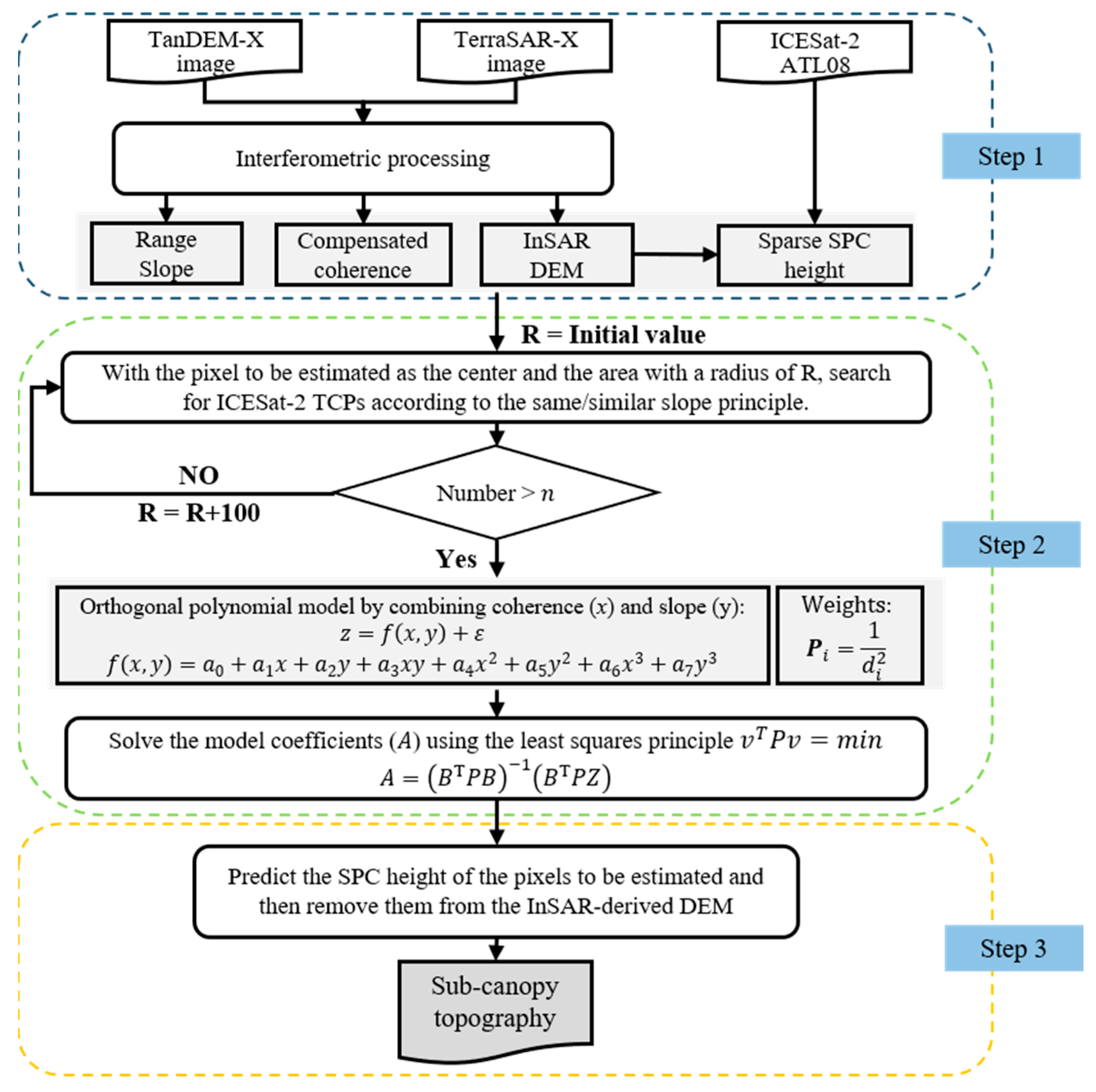
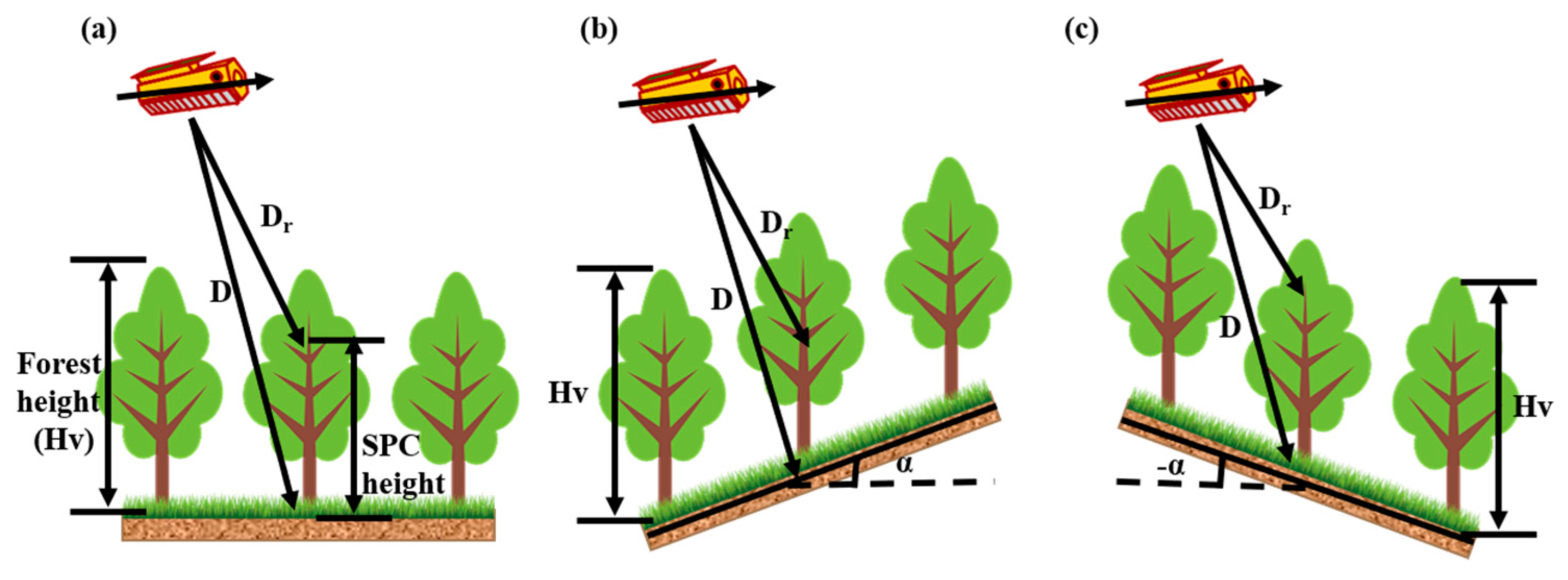
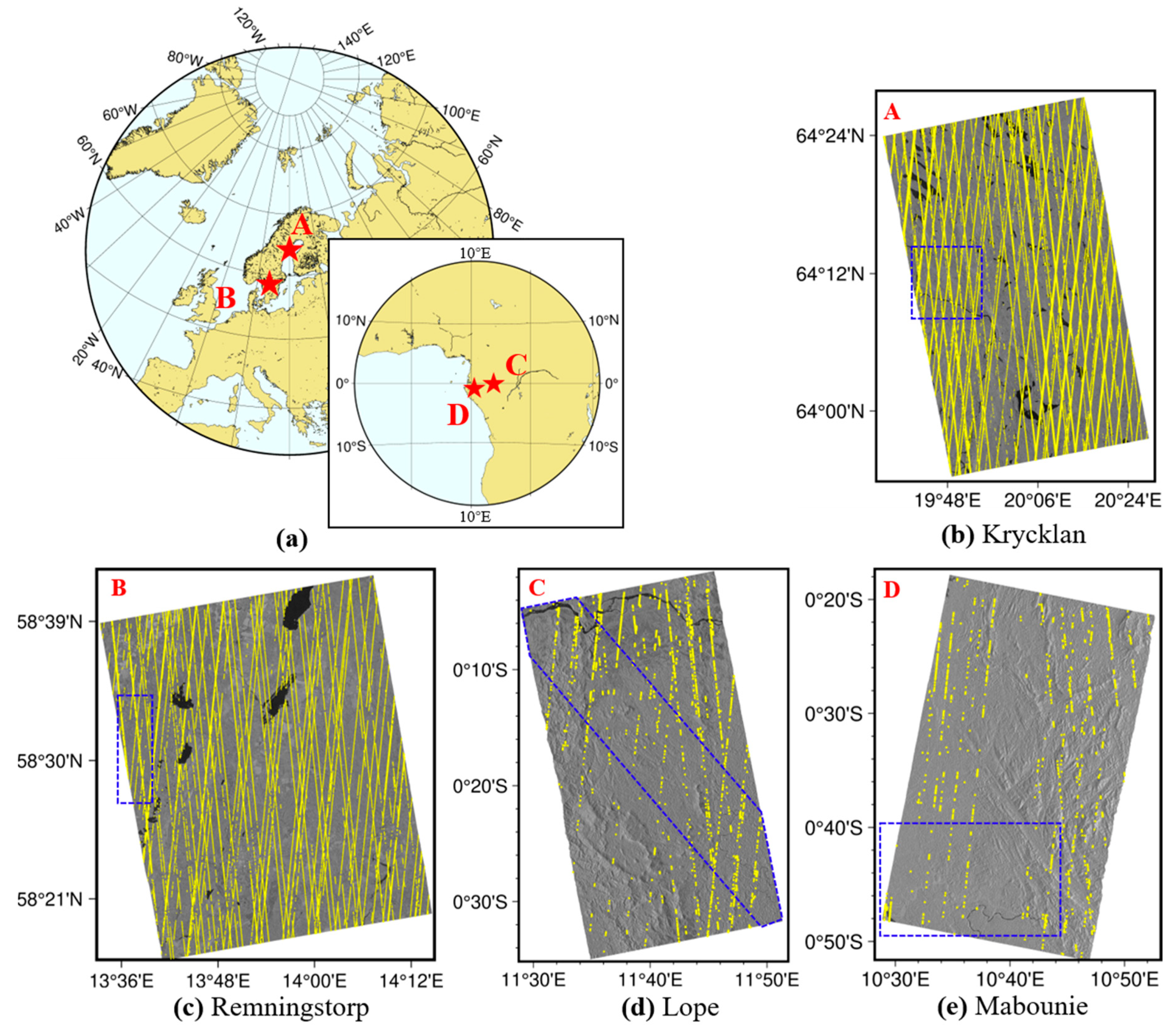


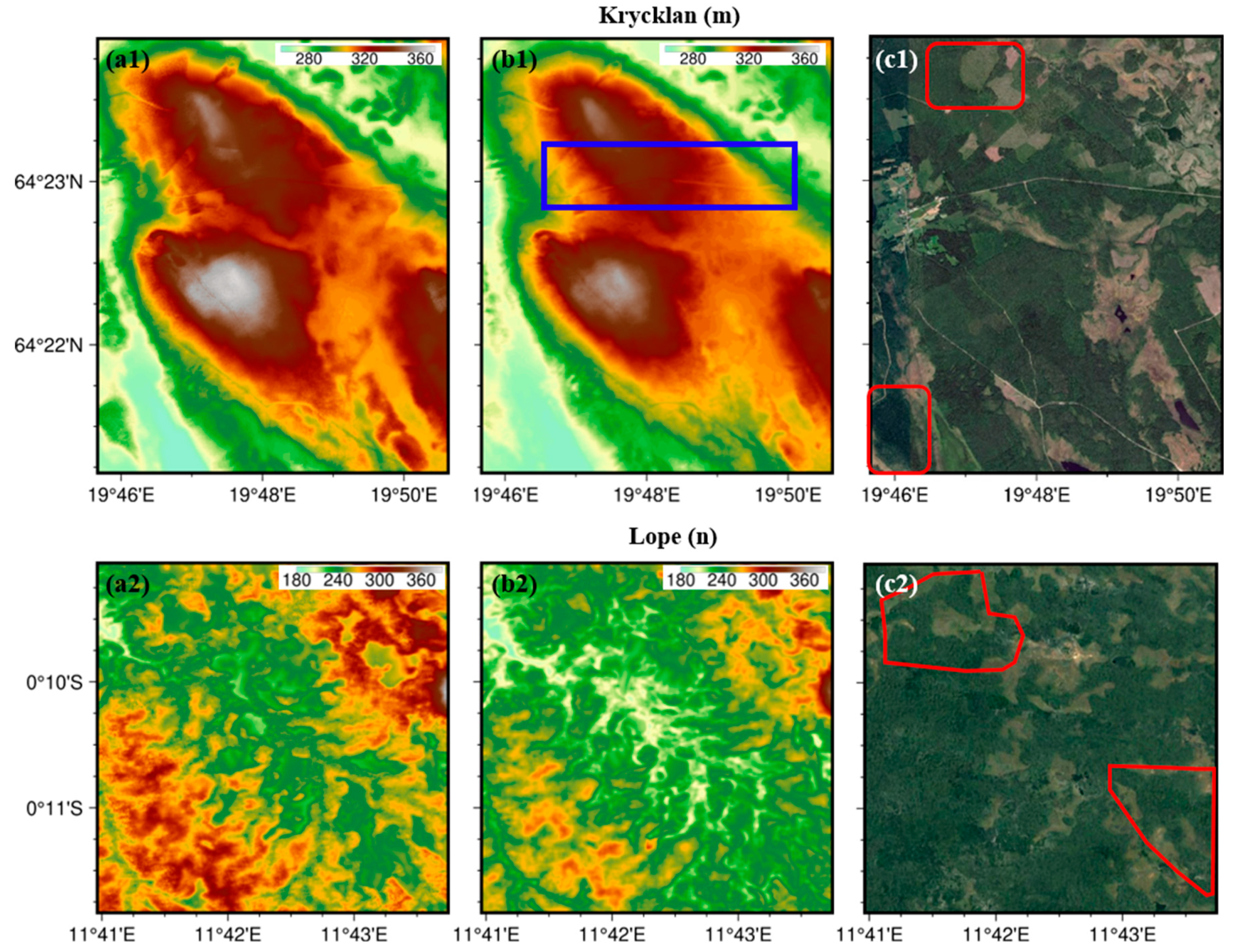

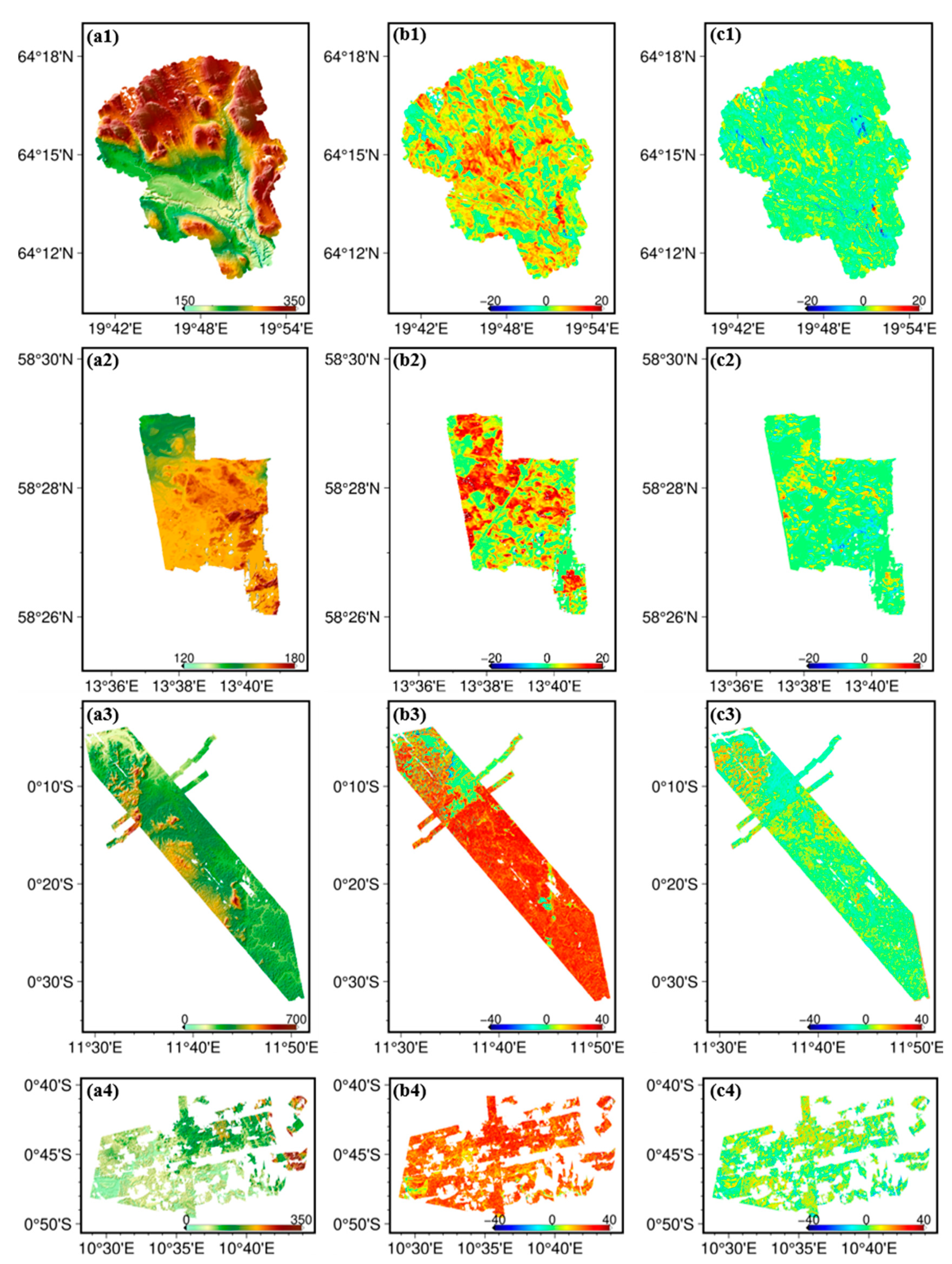
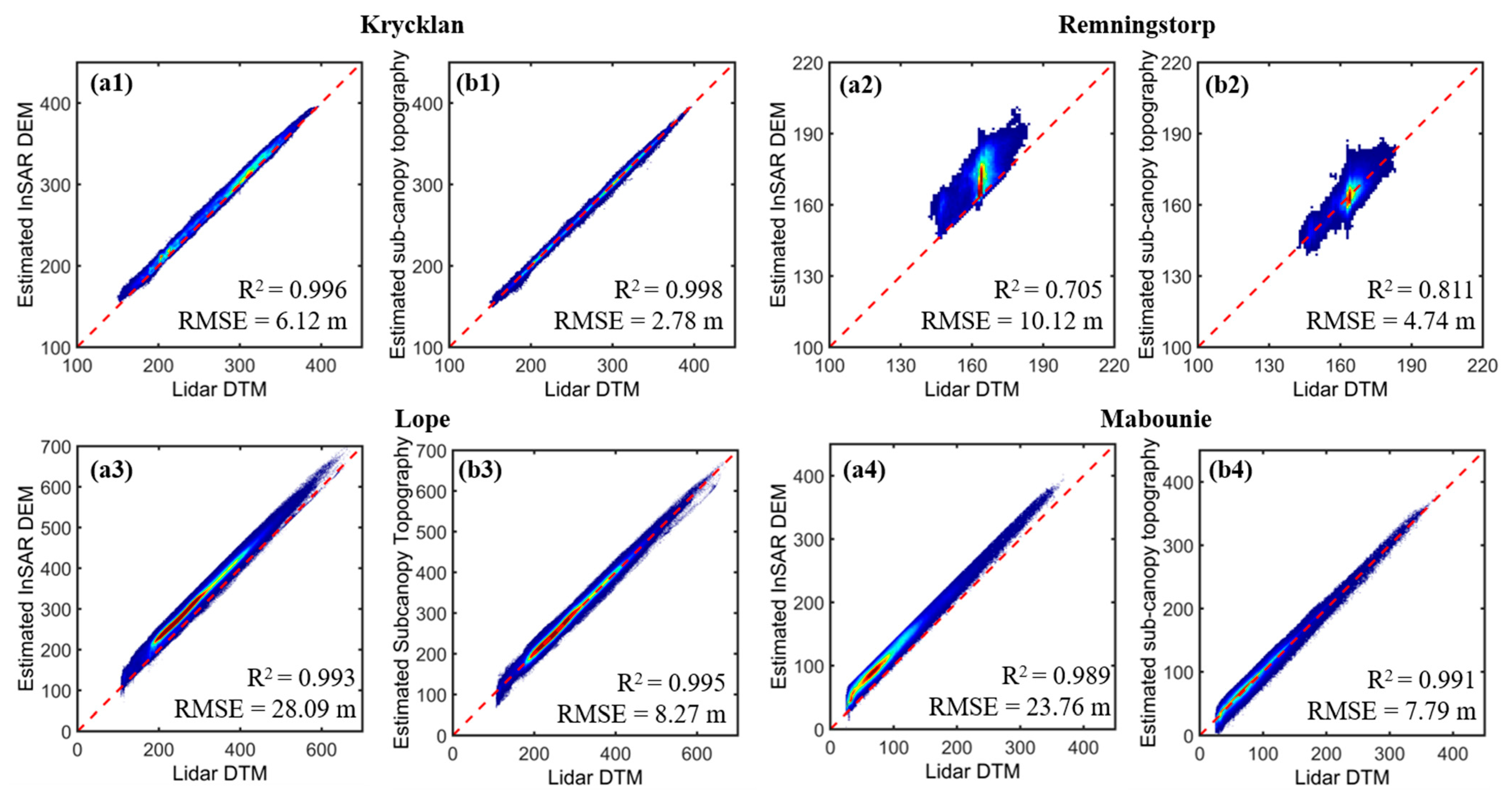

| Test Site | Date | Incidence Angle (°) | Baseline (m) | HoA (m) | Polarization |
|---|---|---|---|---|---|
| Krycklan | 28 July 2012 | 41.5° | 185.9 | −37.5 | HH |
| Remningstorp | 19 December 2011 | 41.5° | 110.1 | −65.9 | HH |
| Lope | 25 March 2014 | 45.9° | 103.4 | 75.6 | HH |
| Mabounie | 5 November 2011 | 34.6° | 114.3 | 50.5 | HH |
| Test Site | Number | Percentage |
|---|---|---|
| Krycklan | 43,227 | 0.19% |
| Remningstorp | 69,820 | 0.28% |
| Lope | 5419 | 0.04% |
| Mabounie | 3194 | 0.03% |
| Forest Height (m) | InSAR-Derived DEM—LiDAR DTM | Coherence | InSAR-Derived DEM—LiDAR DSM | ||||
|---|---|---|---|---|---|---|---|
| Mean (m) | STD (m) | Deviation Pixel Ratio (%) | Mean | Mean (m) | STD (m) | Deviation Pixel Ratio (%) | |
| Krycklan | |||||||
| 0~10 | 0.93 | 2.08 | 56.52 | 0.84 | −5.54 | 2.60 | 96.25 |
| 10~20 | 5.05 | 3.28 | 91.76 | 0.82 | −10.47 | 3.28 | 99.88 |
| 20~30 | 8.25 | 4.70 | 94.77 | 0.65 | −13.99 | 4.59 | 99.98 |
| Remningstorp | |||||||
| 0~10 | 2.12 | 5.72 | 58.73 | 0.86 | −2.82 | 6.01 | 84.97 |
| 10~20 | 6.69 | 5.32 | 92.50 | 0.81 | −9.40 | 5.31 | 99.88 |
| 20~30 | 10.89 | 5.82 | 95.66 | 0.71 | −12.66 | 5.60 | 99.98 |
| >30 | 15.73 | 8.27 | 94.25 | 0.66 | −15.37 | 8.19 | 100.00 |
| Lope | |||||||
| 0~10 | 0.79 | 8.72 | 80.96 | 0.84 | −4.04 | 8.80 | 92.83 |
| 10~20 | 5.14 | 9.59 | 89.66 | 0.79 | −9.55 | 9.53 | 96.45 |
| 20~30 | 11.89 | 7.89 | 97.21 | 0.75 | −13.86 | 7.57 | 98.62 |
| 30~40 | 22.56 | 6.27 | 99.82 | 0.72 | −13.93 | 5.74 | 99.33 |
| 40~50 | 29.64 | 6.47 | 99.98 | 0.68 | −14.68 | 6.06 | 99.24 |
| >50 | 36.67 | 8.48 | 99.99 | 0.73 | −15.73 | 8.26 | 99.95 |
| Mabounie | |||||||
| 0~10 | 3.58 | 3.02 | 75.81 | 0.81 | −1.73 | 4.29 | 88.90 |
| 10~20 | 5.76 | 2.74 | 94.78 | 0.72 | −10.44 | 3.03 | 96.03 |
| 20~30 | 16.07 | 6.16 | 99.73 | 0.63 | −10.42 | 5.98 | 98.01 |
| 30~40 | 22.64 | 6.63 | 99.93 | 0.51 | −12.67 | 6.38 | 98.65 |
| >40 | 28.32 | 8.44 | 99.90 | 0.46 | −15.95 | 8.50 | 98.76 |
| Test Site | InSAR-Derived DEM (RMSE) | Sub-Canopy Topography (RMSE) | |||||
|---|---|---|---|---|---|---|---|
| Case 1 | Case 2 | Proposed Method | |||||
| Krycklan | 6.12 m | 3.49 m | 43.1% ↑ | 3.41 m | 44.2% ↑ | 2.78 m | 54.5% ↑ |
| Remningstorp | 10.12 m | 4.89 m | 51.6% ↑ | 5.39 m | 46.7% ↑ | 4.74 m | 53.1% ↑ |
| Lope | 28.09 m | 12.40 m | 55.8% ↑ | 12.05 m | 57.1% ↑ | 8.27 m | 70.5% ↑ |
| Mabounie | 23.76 m | 10.18 m | 57.2% ↑ | 10.21 m | 57.1% ↑ | 7.79 m | 67.2% ↑ |
| VCF data | p184r060, p184r061, p185r060, p185r061, p194r015, p195r019 | ||||||
Disclaimer/Publisher’s Note: The statements, opinions and data contained in all publications are solely those of the individual author(s) and contributor(s) and not of MDPI and/or the editor(s). MDPI and/or the editor(s) disclaim responsibility for any injury to people or property resulting from any ideas, methods, instructions or products referred to in the content. |
© 2024 by the authors. Licensee MDPI, Basel, Switzerland. This article is an open access article distributed under the terms and conditions of the Creative Commons Attribution (CC BY) license (https://creativecommons.org/licenses/by/4.0/).
Share and Cite
Hu, H.; Zhu, J.; Fu, H.; Liu, Z.; Xie, Y.; Liu, K. Automated Estimation of Sub-Canopy Topography Combined with Single-Baseline Single-Polarization TanDEM-X InSAR and ICESat-2 Data. Remote Sens. 2024, 16, 1155. https://doi.org/10.3390/rs16071155
Hu H, Zhu J, Fu H, Liu Z, Xie Y, Liu K. Automated Estimation of Sub-Canopy Topography Combined with Single-Baseline Single-Polarization TanDEM-X InSAR and ICESat-2 Data. Remote Sensing. 2024; 16(7):1155. https://doi.org/10.3390/rs16071155
Chicago/Turabian StyleHu, Huacan, Jianjun Zhu, Haiqiang Fu, Zhiwei Liu, Yanzhou Xie, and Kui Liu. 2024. "Automated Estimation of Sub-Canopy Topography Combined with Single-Baseline Single-Polarization TanDEM-X InSAR and ICESat-2 Data" Remote Sensing 16, no. 7: 1155. https://doi.org/10.3390/rs16071155






